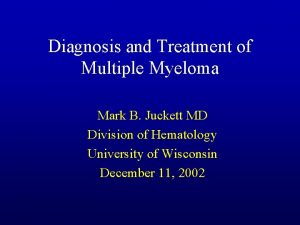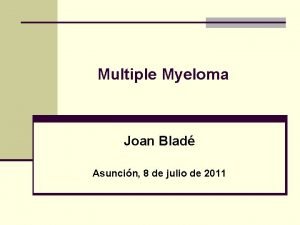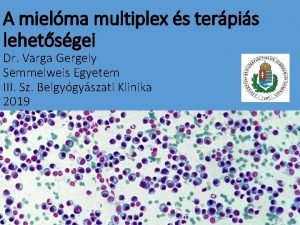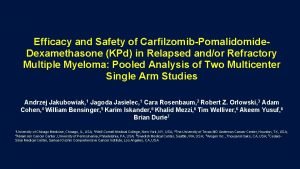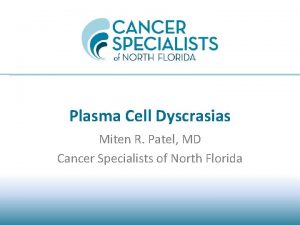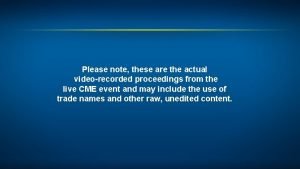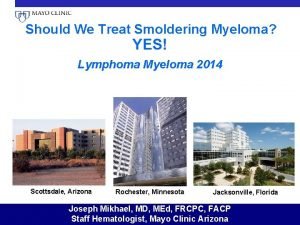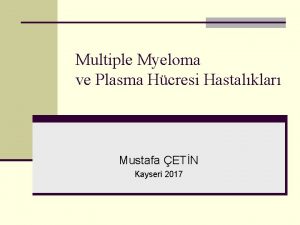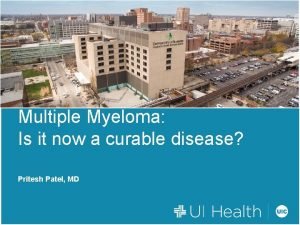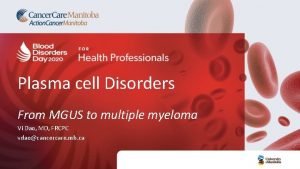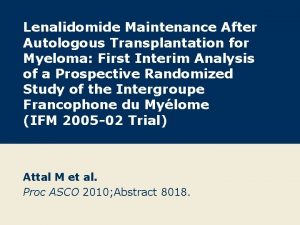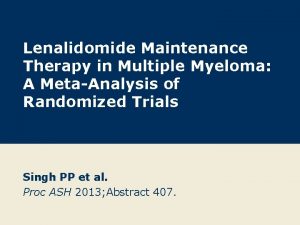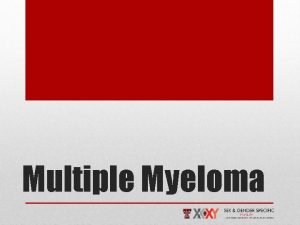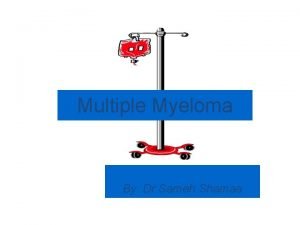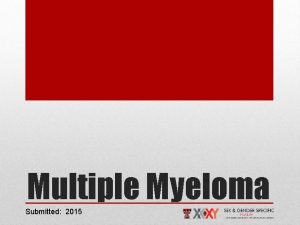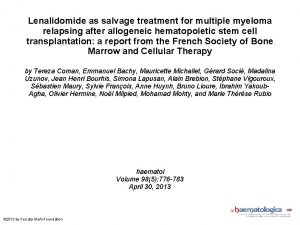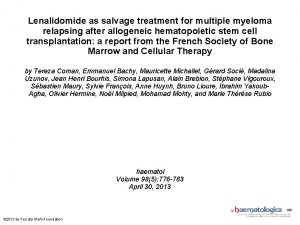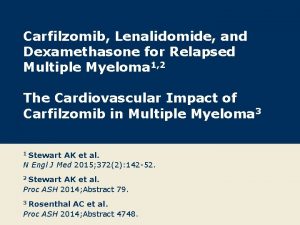Lenalidomide Maintenance After StemCell Transplantation for Multiple Myeloma










- Slides: 10

Lenalidomide Maintenance After Stem-Cell Transplantation for Multiple Myeloma: Follow-Up Analysis of the IFM 2005 -02 Trial Attal M et al. Proc ASH 2013; Abstract 406.

Background The IFM protocol for this study was designed to develop the role of lenalidomide (Len) as maintenance therapy after transplantation for patients with multiple myeloma (MM). l Previously, results from the IFM 2005 -02 trial, after a follow-up period of 45 months, demonstrated that Len maintenance (NEJM 2012; 366(19): 1782): – Significantly improved progression-free survival (PFS) without significant impact on overall survival (OS) – Increased rates of Grade 3/4 neutropenia, infections, deep vein thrombosis and second primary malignancies (SPMs) l Study objective: To determine the efficacy and safety of Len maintenance therapy after first-line autologous stem cell transplantation (ASCT) for patients with MM after a longer follow-up period. l Attal M et al. Proc ASH 2013; Abstract 406.

Phase III IFM 2005 -02 Trial Design Eligibility (n = 614) Patients with nonprogressive disease ≤ 6 months after first-line ASCT for MM <65 years 1: 1 R* Maintenance Len 10 -15 mg/d† (n = 307) Maintenance placebo (n = 307) * All patients initially received consolidation therapy with Len (25 mg/d) on days 1 -21 every 28 days for 2 months. † 10 mg per day for the first 3 months, increased to 15 mg if tolerated • Recruitment took place from July 2006 through August 2008. • In January 2011 the Data and Safety Monitoring Board (DSMB) recommended the discontinuation of Len due to increased incidence of SPMs. • Primary endpoint: PFS • No patient on the placebo arm received Len before progression. Attal M et al. Proc ASH 2013; Abstract 406; N Engl J Med 2012; 366(19): 1782 -91.

Survival Results from Randomization Len (n = 307) Placebo (n = 307) p-value Median PFS 46 mo 24 mo <0. 001 5 -year PFS 42% 18% <0. 0001 OS Len Placebo p-value 82 mo 81 mo 0. 80 PFS Median OS • The median duration of Len maintenance therapy was 2 years. • As of November 2013, the median follow-up was 77 months from diagnosis and 67 months from randomization. • Discrepancy between PFS and OS remained: - Poor outcome after disease progression for patients on the Len maintenance group was a likely hypothesis. - In order to confirm this hypothesis, additional analyses were performed. Attal M et al. Proc ASH 2013; Abstract 406.

Second PFS Median second PFS Placebo (n = 241) Len (n = 165) p-value 24 mo 13 mo <0. 001 Attal M et al. Proc ASH 2013; Abstract 406.

Second PFS According to Treatment at First Progression Total (n = 614) Placebo (n = 307) Len (n = 307) Patients experiencing first progression (n) 406 241 165 Patients requiring treatment for first progression (n) 369 215 154 IMi. D-based regimen Total (n = 181) Placebo (n = 134) — 19 mo 8 mo (n = 94) (n = 31) (n = 63) — 8 mo 9 mo (n = 92) (n = 50) (n = 42) — 30 mo 18 mo Median second PFS Bortezomib-based regimen Median second PFS No new agents Median second PFS Attal M et al. Proc ASH 2013; Abstract 406. Len (n = 49) p-value 0. 003 0. 28 0. 06

OS After First Progression Median OS Len (n = 165) Placebo (n = 241) p-value 29 mo 48 mo <0. 001 Attal M et al. Proc ASH 2013; Abstract 406.

Incidence of SPMs Len Placebo Total Hematologic 18 7 25 AML/MDS 7 4 11 ALL 1 1 2 Lymphoma 6 1 7 Hodgkin lymphoma 4 1 5 13 11 24 Esophageal/hypopharynx 2 0 2 Colon and rectal 4 1 5 Prostate 3 3 6 Lung cancer 0 1 1 Bladder/renal 1 2 3 Breast 2 1 3 Melanoma 1 3 4 9 5 14 37 (13%) 21 (7%) 58 Solid tumor Noninvasive skin cancer Total (patients can have >1 SPM) Attal M et al. Proc ASH 2013; Abstract 406.

Author Conclusions l This new analysis confirms that Len is an effective treatment to prolong PFS (median 46 mo vs 24 mo, p < 0. 001) after ASCT for patients with MM: – Reduced second PFS (median 24 mo vs 13 mo, p < 0. 001), possibly due to clonal selection or secondary resistance (suggested by the IMi. D and No new agent groups) l PFS benefit is not currently associated with an improved OS because of a shorter survival after the first disease progression (median 29 mo vs 48 mo, p < 0. 001). l The risk of SPMs increased (13% vs 7%) for patients receiving Len maintenance. l The risk of severe neutropenia also increased (51% vs 18%) for patients receiving Len (data not shown). Attal M et al. Proc ASH 2013; Abstract 406.

Investigator Commentary: Follow-Up Analysis of the IFM 2005 -02 Trial of Len Maintenance After ASCT for Patients with MM Of note, the initial analysis of the results from this IFM trial failed to show an OS benefit even though the PFS benefit was the same as in the US CALGB trial (NEJM 2012; 366(19): 1770). Some big differences between these 2 studies are that the IFM trial included 2 cycles of Len as consolidation and early trial termination resulted in patients receiving Len maintenance for a median of 2 years. The CALGB trial did not have a consolidation step and Len maintenance was administered longer, until disease progression. After a median follow-up of 77 months, this trial continues to show an improvement in PFS but no OS benefit. We continue to see a warning about the development of SPMs for patients receiving Len maintenance. If you compare these results to the data from 2 trials that showed OS benefit — the US trial and the Phase III trial of early transplant versus no transplant with a second randomization to Len or no maintenance (Proc ASCO 2013; Abstract 8509) — 2 issues are evident with the use of Len maintenance. Side effects occur, and a higher risk of SPMs exists with Len maintenance, although that’s a relatively low risk compared to the risk of MM relapse. If you limit therapy to 2 years, you’re opening yourself up to all the risks and toxicities of therapy without necessarily allowing your patient to realize the survival benefit reported for patients who receive treatment until progression. Interview with Sagar Lonial, MD, January 22, 2014
